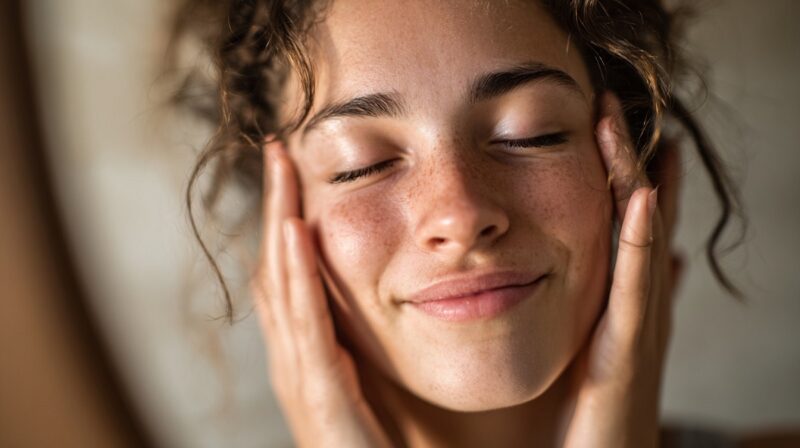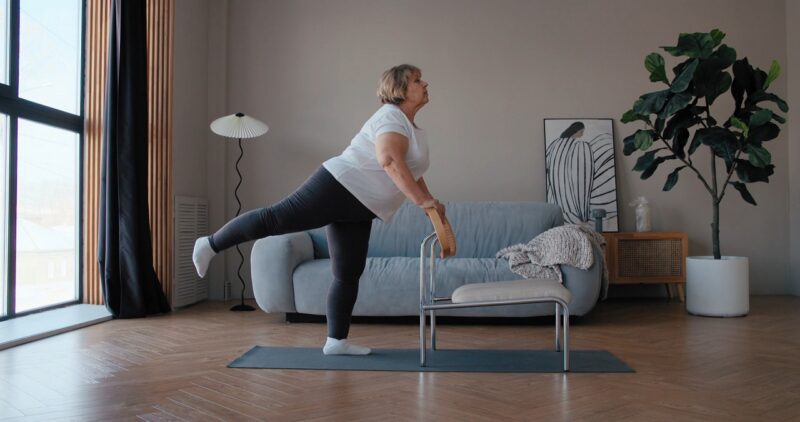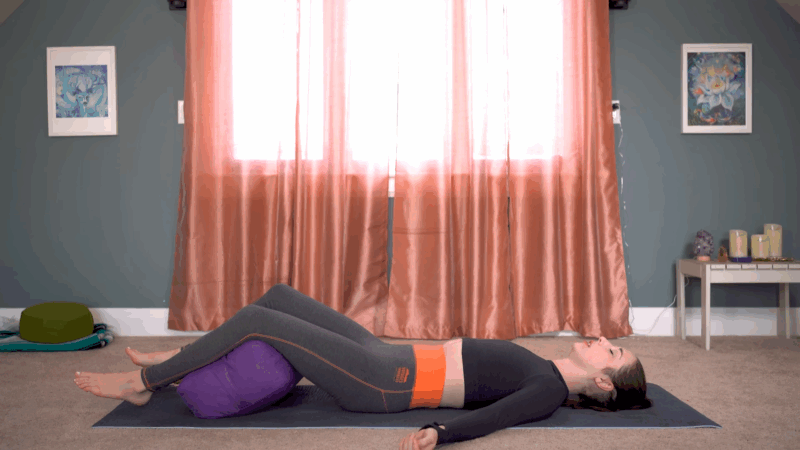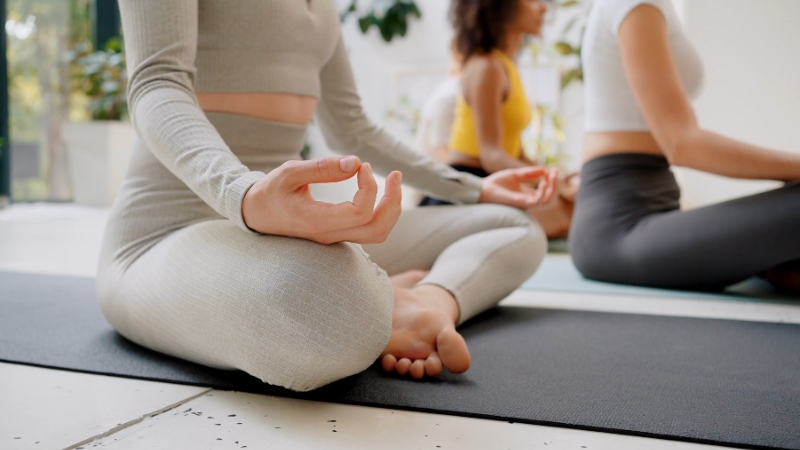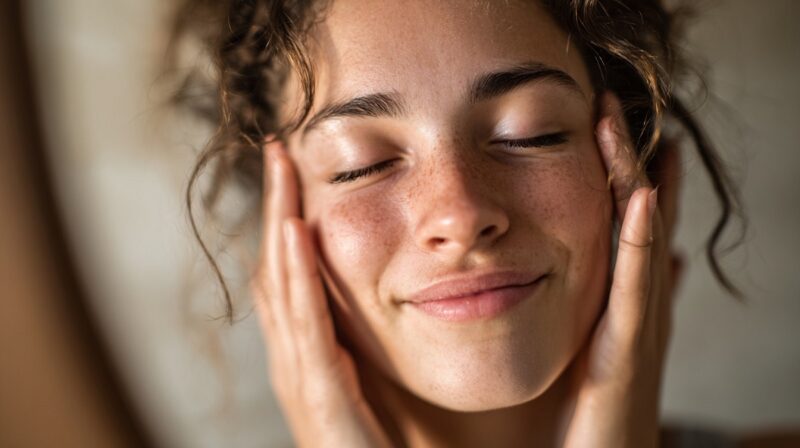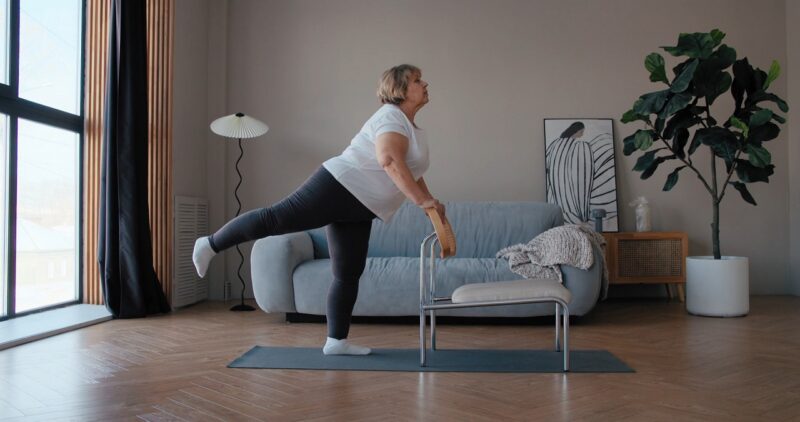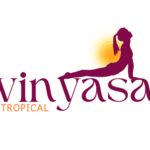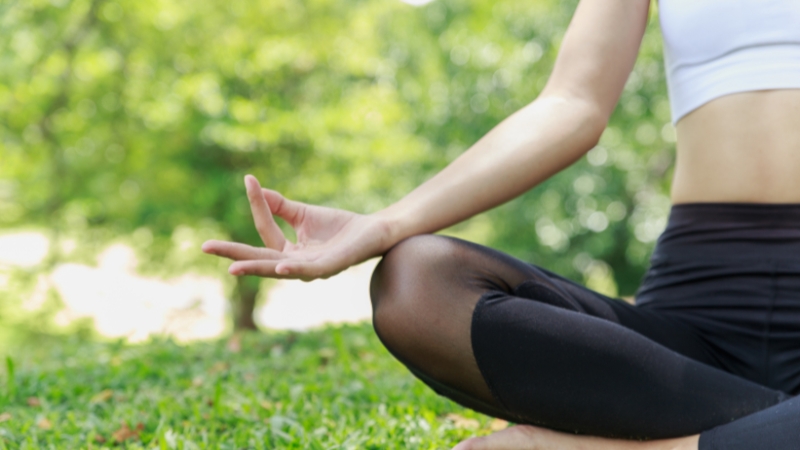
Share Post:
Millions of people worldwide battle the debilitating effects of migraines, seeking relief beyond traditional medications. Yoga for migraine relief has emerged as a powerful, natural approach that addresses both the physical tension and emotional stress that often trigger severe headaches.
Recent research shows that regular yoga practice can reduce migraine frequency by up to 50% and significantly decrease pain intensity when headaches occur.
You will discover how specific yoga poses target migraine triggers, learn evidence-based techniques for immediate pain relief, and develop a sustainable practice that may prevent future episodes.
Modern studies demonstrate that yoga works by restoring balance to your nervous system, improving blood flow, and releasing muscle tension in key areas where migraines often originate.
How Yoga Helps Migraines
A 2020 study published in the medical journal Neurology found that people with migraine who did yoga for 3 months reported fewer and less intense headaches than those who received medication alone. Participants were able to reduce their migraine medication to approximately half their usual dose while maintaining better symptom control.
Some patients also found that incorporating face yoga alongside traditional postures enhanced relaxation and reduced tension in facial and scalp muscles, areas often affected during migraine episodes.
The physiological mechanisms underlying yoga’s effectiveness in relieving migraines involve multiple systems. Yoga improves cardiac autonomic balance, and disturbances in the autonomic nervous system and circulatory system regulation are associated with migraines.
When balance is restored through consistent practice, the likelihood of migraine episodes decreases significantly.
Research data shows compelling results for yoga practitioners. After six weeks of intervention, migraine patients reported headache intensity scores dropping from 7.73 to 2.03 in the yoga group compared to a minimal reduction in the conventional care group.
Heart rate variability also improved, indicating better stress resilience and autonomic function.
4 Essential Yoga Poses for Migraines
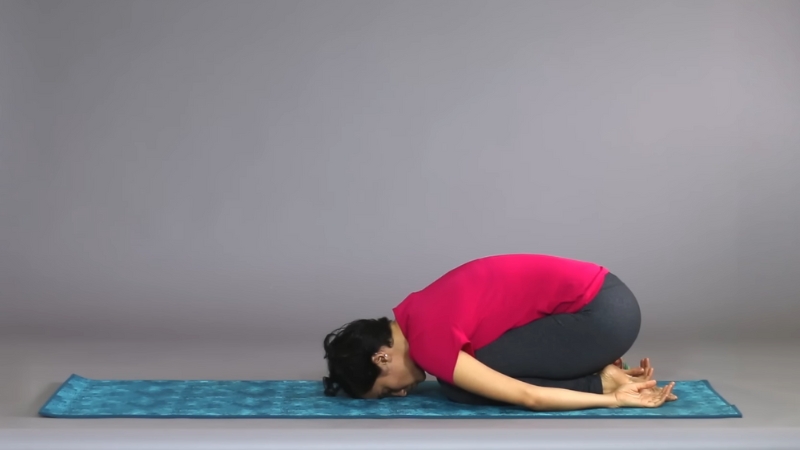
1. Child’s Pose (Balasana) for Deep Relaxation
Child’s Pose serves as the foundation for migraine relief through yoga. Kneel on your mat with toes touching and knees hip-width apart.
Sit back on your heels and fold forward, extending arms ahead or resting them alongside your body. Allow your forehead to gently touch the ground.
Hold each position for 2-5 minutes, focusing on slow, deep breathing. The gentle inversion increases circulation to the head without creating pressure.
Compression in the abdomen stimulates the vagus nerve, activating the parasympathetic nervous system, which is responsible for promoting calm and recovery states. Modifications make the pose accessible for everyone by placing a pillow under your torso for support.
2. Forward Fold (Uttanasana) for Tension Release
Standing forward folds target neck and shoulder tension, commonly associated with migraine development. Stand with feet hip-width apart and slowly hinge at the hips, allowing arms to hang toward the floor.
Bend knees as needed to maintain comfort and prevent strain.
The gentle inversion encourages blood flow to the brain while releasing tension in the lower back. Hold for 1-3 minutes, swaying gently side to side to release additional tension. Focus on lengthening the spine rather than forcing depth in the fold.
For those with lower back concerns, practice seated forward folds instead.
3. Legs Up the Wall (Viparita Karani) for Circulation
Legs Up the Wall pose offers profound relief for migraine symptoms through passive inversion and complete relaxation. Lie on your back near a wall and extend your legs up against it.
Arms rest comfortably at your sides with palms facing up.
The pose promotes venous return, reducing pressure in the head and neck while calming the nervous system. Stay in position for 10-20 minutes, allowing gravity to assist circulation and muscle relaxation.
Breathing becomes naturally deeper in the pose, activating the parasympathetic response that counters the effects of stress hormones.
4. Cat-Cow Stretch (Marjaryasana-Bitilasana) for Spinal Mobility
Cat-Cow movements address cervical spine stiffness that often contributes to migraine development. Begin in a tabletop position on hands and knees.
Alternate between arching your back (cow pose) and rounding your spine (cat pose) with slow, controlled movements.
Coordinate your breath with movement: inhale for Cow Pose, exhale for Cat Pose. Continue for 1-2 minutes, focusing on smooth transitions rather than extreme ranges of motion.
The rhythmic movement stimulates cerebrospinal fluid circulation, potentially reducing intracranial pressure associated with migraines.
Breathing Exercises for Migraine Relief
Alternate Nostril Breathing (Nadi Shodhana)
Alternate nostril breathing helps balance the nervous system and reduce migraine frequency through regulated breathing techniques. Sit comfortably with your spine straight.
Use your right thumb to close your right nostril and inhale through your left nostril. Close the left nostril with your ring finger, release the thumb, and exhale right.
Continue the pattern for 5-10 cycles, maintaining a slow, steady breath rhythm. The practice balances sympathetic and parasympathetic nervous system activity, reducing the autonomic dysfunction associated with migraine development.
Research shows consistent practice can reduce headache frequency by up to 40%.
4-7-8 Breathing for Acute Relief
The 4-7-8 breathing pattern provides rapid nervous system calming for acute migraine relief. Inhale through your nose for four counts, hold for seven counts, and exhale through your mouth for eight counts. Repeat 4-8 cycles, focusing on complete exhalation.
The extended exhale activates the vagus nerve, triggering relaxation responses that can interrupt migraine progression. Practice the technique at the first sign of headache symptoms for maximum effectiveness.
Many practitioners report a reduction in pain intensity when the intervention occurs early.
Restorative Yoga for Migraines
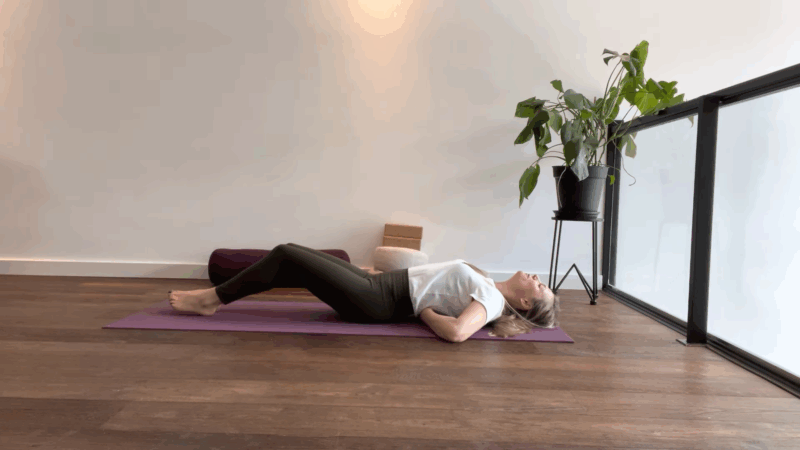
Supported Child’s Pose Variation
Enhanced Child’s Pose using props offers a more profound relaxation experience for migraine relief. Place a bolster or several pillows lengthwise between your legs before folding forward. Rest your torso completely on the support with arms relaxed alongside.
The supported version allows complete muscular release without effort, enabling longer hold times of 10-20 minutes. Cover yourself with a blanket to maintain warmth and promote more profound relaxation.
The pose creates optimal conditions for a nervous system reset during migraine episodes.
Supported Fish Pose for Chest Opening
Supported Fish Pose counteracts the forward posture that contributes to neck tension and migraines. Place a bolster or rolled blanket perpendicular to your spine at mid-back level.
Lie back with your shoulder blades resting on the support and arms open wide.
The gentle backbend opens restricted chest muscles while supporting the natural cervical curve. Hold for 10-15 minutes, allowing gravity to release accumulated tension.
The pose improves breathing capacity and reduces upper body stress patterns.
Building Your Daily Practice for Prevention

Morning Routine for Energy Balance
Start each day with a 10-15 minute sequence targeting migraine prevention. Begin with gentle neck rolls and shoulder shrugs to release tension that has built up overnight.
Progress through Cat-Cow movements, standing forward fold, and conclude in Child’s Pose, focusing on deep breathing.
Consistency matters more than duration for preventing migraines through exercise. Even 5 minutes of daily practice provides cumulative benefits for nervous system regulation and stress resilience.
Morning practice establishes positive patterns before daily stressors accumulate.
Evening Wind-Down Sequence
Evening practice focuses on releasing accumulated stress and preparing for restorative sleep. Begin with seated spinal twists to release tension in the back, followed by Legs Up the Wall pose to improve circulation. End with alternate nostril breathing to balance nervous system activity.
Poor sleep quality significantly increases migraine risk, making evening routines particularly important. The calming sequence helps transition from daily activity to rest, supporting natural circadian rhythms that influence headache patterns.
Holistic Migraine Treatment

Stress Reduction and Migraines Connection
Chronic stress maintains elevated cortisol levels that increase migraine susceptibility through multiple pathways. Yoga practice directly counteracts stress hormones while building resilience against unavoidable stressors.
The mind-body connection in yoga addresses both physical tension and emotional stress patterns that contribute to the development of headaches.
Workplace stress represents a major migraine trigger for many individuals. Simple desk-based yoga stretches throughout the workday can help maintain muscle relaxation and balance stress hormones.
Three-minute breathing breaks can prevent tension accumulation that might otherwise trigger evening headaches.
Nutritional Considerations for Practitioners
Proper hydration becomes especially important when combining yoga practice with migraine management. Dehydration ranks among the top migraine triggers and can be exacerbated by increased activity levels. Drink water before, during, and after practice sessions.
Timing meals around yoga practice affects both comfort and migraine risk. Practice on an empty stomach when possible, allowing 2-3 hours after large meals. Low blood sugar can trigger migraines, so light snacks may be appropriate for longer sessions.
Measuring Progress and Success
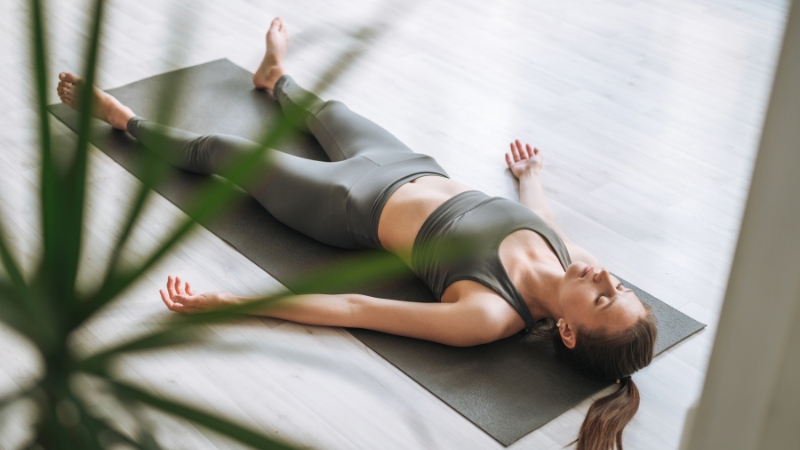
Tracking Migraine Patterns
Detailed headache diaries help identify patterns and measure the effectiveness of yoga practice. Record headache frequency, intensity, duration, and potential triggers alongside practice consistency.
Note the correlation between yoga practice timing and migraine patterns.
Track medication usage alongside practice consistency to identify potential reductions over time. Studies show yoga practitioners often reduce migraine medication to approximately half their usual dose while maintaining better symptom control.
Consult your healthcare provider before making any changes to your medication.
Setting Realistic Expectations
Migraine relief through yoga typically develops gradually over weeks to months of consistent practice. Initial benefits may include improved sleep quality and stress management before direct headache reduction becomes apparent. Patience and consistency are essential for long-term success.
The best yoga for migraine pain varies significantly between individuals based on triggers, pain patterns, and physical condition. Experiment with different poses and sequences while maintaining consistency in your overall practice. Professional guidance can help optimize individual approaches.
Pose Category
Primary Benefits
Recommended Duration
Best Time
Restorative Poses
Deep relaxation, nervous system reset
10-20 minutes
Evening, during episodes
Gentle Flow
Circulation, tension release
15-30 minutes
Morning, prevention
Breathing Exercises
Quick nervous system balance
5-10 minutes
Anytime, acute relief
Supported Backbends
Posture correction, chest opening
10-15 minutes
Midday, computer breaks
Safety Considerations and Contraindications
@makeitraene Post period headache and migraine, anyone? I experience this every single month and as a yoga teacher, I use my practice to create space for relief, calm, and mindfulness #yoga #vinyasa #flow #yogatok #migraine #painrelief #yogachallenge #yogateacher #yogaflow #headache ♬ Jeju Island – OVN
When to Avoid Certain Poses
Inversions should be avoided during active migraine episodes as they may increase intracranial pressure and worsen symptoms. Forward folds can be modified by bending the knees and maintaining a supported head position to retain benefits while reducing risk.
Hot yoga styles may trigger migraines in susceptible individuals through dehydration and overheating. Room temperatures above 80°F can be problematic for many migraine sufferers.
Well-ventilated, moderately heated spaces are more suitable for sensitive practitioners.
Medical Consultation Guidelines
Consult healthcare providers before beginning yoga practice if you have severe, frequent migraines or take prescription medications. Some migraine medications affect blood pressure and balance, requiring practice modifications for safety.
New or worsening headache patterns warrant a medical evaluation, regardless of the benefits of yoga practice. Yoga complements but does not replace appropriate medical care for severe neurological conditions.
FAQ
Related Posts:
- 10 Easy 2-Person Yoga Poses for Beginners - Sync…
- Should You Do Yoga with Hernia? Poses to Try And…
- 10 Must-Try Yoga Wheel Poses for a Complete Body Workout
- Post-Surgery Recovery Yoga: Safe Poses and Precautions
- What Is Blindfold Yoga - Power of Trusting Your…
- Introduction to Vinyasa Yoga - Elevate Your Practice




